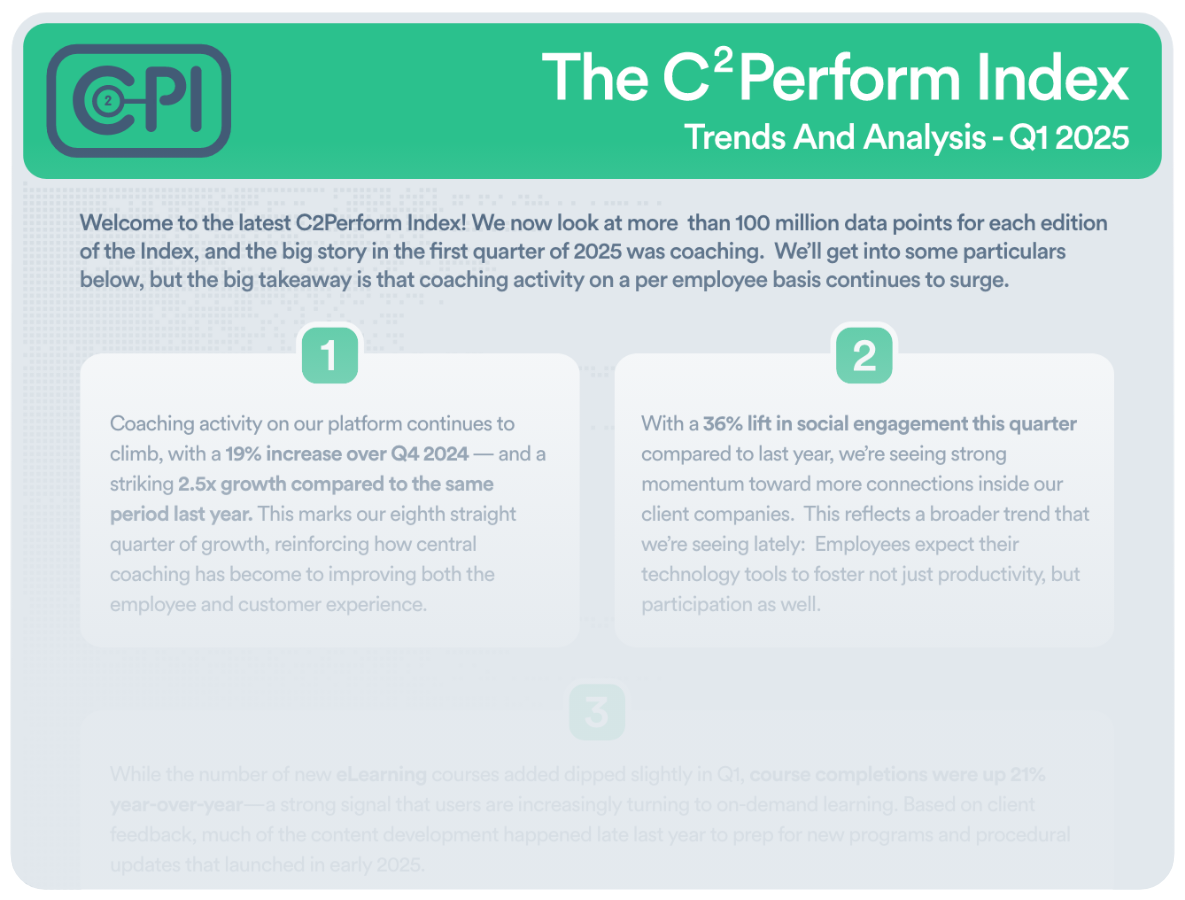Here’s a stat that will get your attention: According to the Gallup Organization, only 28% of employees strongly believe that the feedback they receive helps them do better work.
Being a good coach can be hard, for a lot of reasons. It takes time to put together an effective session – pulling together performance data, following up on the last session, finding actual time to coach in the middle of a busy day. It can be awkward because sometimes you have to deliver constructive feedback that isn’t always easy. Finally, it involves understanding human behavior and including the right mix of relationship building, development, and mentoring.
We’ve seen some great examples of coaching over the years, and here are seven ideas to help you be a better coach for your team.
1. Make sure you’re having two-way conversations
When it’s time to coach, be sure the communication flows both ways (especially if the coaching session is to address performance issues). Ask your employees for structured input in each interaction so you build a level of trust and to get your team to share their ideas and suggestions. Your customer-facing employees deserve to be heard, and they’re a valuable source of input.
One approach we like: Structuring coaching sessions around three questions:
- What’s working?
- What’s not?
- What do you need from me to succeed?
Involving your teams in the development of their own skills can also foster a sense of ownership and responsibility among them. When they feel like they are an important part of the team because their feedback matters, there’s a greater sense of ownership in the role and willingness to go above and beyond when it comes to providing excellent customer service – a critical component to delivering on your company’s customer experience (CX).
2. Help employees set goals and stay on track
In order for your teams to improve performance, you’ve got to give them a way measure progress. Good Coaching includes setting individual or team goals that are achievable but challenging and then providing feedback on a consistent basis so everyone can see how well they are doing. Be sure to recognize achievement along the way and reward employees with positive reinforcement to keep them motivated.
Employees who can see tangible evidence of their progress are more likely to stay engaged and continue working hard towards meeting or exceeding expectations. This also applies to members of the team who may be struggling – so don't ever be afraid to offer help and constructive feedback (but always be respectful).
As a supervisor or manager, make sure that tools and resources that help employees achieve their goals are readily available and that people understand how to use them. In addition to regular feedback sessions with each individual employee or team, offer one-on-one training as needed to address critical needs.
3. Foster a team-oriented environment
Face it, we’ve moved to a new way of working that may or may not return to what we used to consider “normal.” With the move to a heavy reliance on a remote workforce, the ability to create a positive team atmosphere has its challenges... but it’s more important than ever.
The pros and cons of virtual meetings will continue to be questions, but what shouldn’t be up for debate is the absolute need to increase the amount of communication with your team. Many of the things you would ordinarily do in person can be done virtually – even if it doesn’t feel the same – so keep doing them. What’s important is to keep communicating, even over communicating, so your team gets to know each other better and to develop a sense of camaraderie and teamwork that will be critical when someone needs support. Group coaching sessions are a great way to do this.
In addition, celebrate successes together as a team – like achieving goals that we mentioned above. Recognize outstanding individual outcomes or team successes with everyone. The old adage is correct: Success breeds success.
4. Promote continuous learning
The more confident your team members are, the more engaged they feel. A great coach is always looking for new and innovative ways to help their teams learn. Beyond making sure employees have access to the latest tools, technologies, and techniques that can help them deliver on your company’s CX promise, coaches need to be active listeners when it comes to employee suggestions on skills improvement.
Whether you use the tools in C2Perform or not, there are a variety of ways to make sure your team is learning continuously. Some of our favorites are:
- Regular “Micro” learnings (3 to 5 minutes total) delivered as part of scheduled team meetings
- Letting team members deliver training to the rest of the team – great for employee development
- Reinforcing recent courses with a Question of the Day for 4-5 consecutive days
Coaching employees is all about investing in the individual, and the return on that investment will be well worth it.
5. Lead by example
Although you hear it all the time, it bears repeating: The best coaches are the ones set a good example for their team. This includes behaving in a professional manner at all times, being respectful to customers and employees alike, and exhibiting strong problem-solving skills. As the coach, it's your responsibility to model the behaviors you expect from your team.
If you make a mistake, own up to it and apologize. This will show employees that you are human and capable of making mistakes too, but more importantly, that you are willing to learn from them. It also sends the message that you are open to feedback, which is essential for any coach.
One of the biggest pitfalls to avoid as a coach is becoming too comfortable and believing that you are “above it all.” Remember, your role includes accountability for everything from performance numbers to team morale. If something goes wrong or if one of your employees feels like they've been slighted in some way, own it, talk about it (get help if you need it), reach a solution and implement it. You’re going to make mistakes, and that’s okay. Just do everything you can not to make the same mistake again.
It's also important to remember that coaching is not something you do alone. You may be the official leader of your team, but everyone within it has a crucial role in its success and failure as well. You are dealing with people who are more than just employees; they're individuals with thoughts, feelings and motivations outside work hours.
6. Encourage employees to push their boundaries
Improving skill sets can require people to move outside their comfort zone. Encourage your team to experiment and take risks in the sense of trying new techniques or approaches that could help them succeed – even if they don't always work out the way you plan.
To be clear, we’re not talking about condoning reckless behavior. But we are talking about providing an environment where employees feel comfortable trying new approaches, so it’s important for you to help your team learn and grow as professionals.
7. Be positive and supportive
The best coaches are positive and encouraging, no matter how bad things may seem at times. That’s not to say everything is always sunshine and daisies. But when mistakes occur (and they will), your job is to provide constructive feedback and a way forward. By being supportive, you send a message that you are a trusted ally and not just someone who’s only pointing out mistakes.
Final Thoughts
Good coaches help their teams develop the skills they’ll need to be successful. They provide feedback and guidance, while also creating an environment that allows for growth and learning. Coaches foster a sense of trust and respect, which helps team members feel confident in their abilities to do their jobs. In addition, good coaches can connect with their teams on a personal level, creating a rapport that makes it easier for everyone to open up and learn.
You’re making an investment in your team each time you coach them. Make the most of that investment and your team will grow and succeed.
 English
English Español
Español









